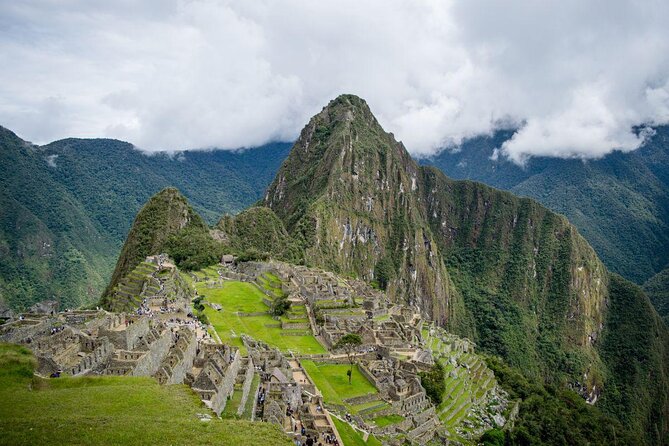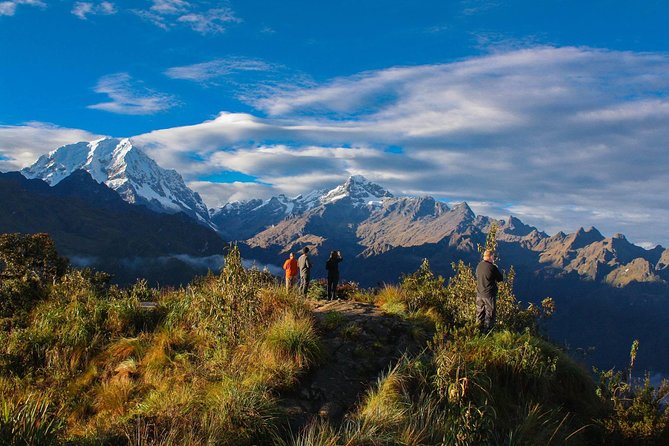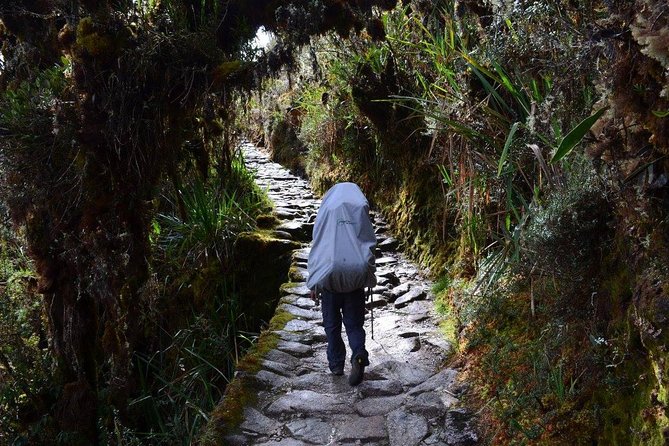Inca Trail to Machu Picchu
Set out on a journey along the fabled Inca Trail to Machu Picchu, a path that weaves through history and nature with every step taken.
The allure of this ancient route lies not only in its physical challenges but in the secrets it holds within its rugged terrain.
As travelers navigate through the Andean landscapes, a sense of wonder and mystery envelops them, offering a glimpse into the enigmatic world of the Incas.
Join the discussion to uncover insights into the hidden treasures that await those who venture on this iconic trail.
Key Points

- Experience breathtaking views and ancient history on the legendary Inca Trail.
- Prepare for challenging terrains with proper fitness and acclimatization.
- Follow regulations and obtain permits for responsible trekking and environmental protection.
- Explore Machu Picchu with local guides, respect site rules, and enjoy hidden gems off the beaten path.
Here's some more nearby activities we've reviewed
Trail Overview

Explore the legendary Inca Trail to Machu Picchu, a renowned trek that offers breathtaking views and a glimpse into the ancient civilization‘s history.
The trail conditions vary from well-maintained paths to challenging terrains, making it crucial to have experienced local guides to navigate safely. These guides not only ensure your safety but also enrich your journey with their knowledge of the area’s flora, fauna, and history.
Apart from the classic route, alternative routes exist, leading to hidden gems off the beaten path. These lesser-known paths offer a more secluded experience and a chance to discover unique archaeological sites and breathtaking landscapes.
Choosing the right route and having expert guides can enhance your adventure on the Inca Trail to Machu Picchu.
Historical Significance
Delving into the historical significance of the Inca Trail to Machu Picchu reveals a rich tapestry of cultural heritage intertwined with natural beauty and ancient engineering marvels. The trail not only serves as a physical connection to the breathtaking Machu Picchu but also stands as a testament to the ingenuity and advanced knowledge of the ancient civilization that constructed it. The Inca Trail is dotted with archaeological wonders, such as Intipata, Sayacmarca, and Wiñay Wayna, showcasing the architectural prowess and strategic planning of the Incas. This ancient route not only provided a path for pilgrimage but also served as a vital link for trade and communication within the vast Inca Empire. Below is a table highlighting key aspects of the Inca Trail’s historical significance:
| Aspect | Description |
|---|---|
| Cultural Heritage | Reflects the traditions, beliefs, and customs of the Inca civilization |
| Architectural Marvels | Showcases the advanced engineering skills of the ancient Incas |
| Historical Significance | Serves as a link to the past, preserving the legacy of the Inca civilization |
| Ancient Civilization | Illustrates the sophistication and organization of the Inca Empire |
Trail Difficulty Level

The historical significance of the Inca Trail to Machu Picchu highlights the challenging yet rewarding trail difficulty level that modern-day hikers can experience. Fitness requirements are demanding due to the trail’s steep ascents and descents, as well as the high altitude challenges encountered along the way.
To prepare for this trek, hikers are advised to engage in regular cardio and strength training exercises to build endurance and leg muscles. Training tips include practicing hiking on inclines and stairs, gradually increasing intensity to mimic the trail conditions.
Health precautions are crucial, with hikers recommended to stay hydrated, protect against the sun, and acclimatize to the altitude before starting the trek. Proper preparation is key to fully enjoy the adventure and reach Machu Picchu successfully.
Packing Essentials

Pack efficiently for the Inca Trail to Machu Picchu by including essential items to ensure a comfortable and safe hiking experience. When packing for this adventure, consider some key tips to make the journey more enjoyable.
Start with a sturdy backpack to carry your gear, including a water bottle to stay hydrated along the trail. Opt for moisture-wicking clothing to keep dry and comfortable during the hike. Don’t forget to bring a good pair of hiking boots for proper foot support and traction on the rugged terrain.
Plus, pack light layers to adjust to changing weather conditions and a reliable headlamp for evening use. These gear recommendations will help you be prepared for the challenges and rewards of the Inca Trail.
Acclimatization Tips
To acclimate effectively to the high altitude of the Inca Trail to Machu Picchu, travelers should gradually increase their elevation exposure before embarking on the trek. Here are some essential acclimatization tips:
-
Stay Hydrated: Proper hydration is crucial at high altitudes to help combat altitude sickness. Travelers should drink plenty of water throughout the day and consider carrying a reusable water bottle to stay hydrated on the trail.
-
Take it Slow: It’s important to pace oneself and avoid overexertion while hiking at high altitudes. Slowing down the pace allows the body to adjust to the reduced oxygen levels gradually, reducing the risk of altitude sickness.
-
Include Rest Days: Planning rest days during the trek can aid in acclimatization. Resting allows the body time to adapt to the altitude and can help prevent altitude-related issues.
Permits and Regulations
Permits for hiking the Inca Trail to Machu Picchu are essential to regulate visitor numbers and protect the environment. To secure a permit, one must apply through an authorized agency or tour operator. The Peruvian government strictly controls the number of hikers on the trail each day, with only 500 permits issued per day, including permits for guides and porters. This limitation helps preserve the fragile ecosystem and prevents overcrowding.
Plus, safety regulations are enforced to ensure the well-being of hikers. These regulations cover aspects like group size, camping restrictions, and waste management practices. By adhering to permit application procedures and safety regulations, visitors can enjoy the trek responsibly while helping to conserve this historic and natural wonder.
Best Time to Visit
When planning your visit to the Inca Trail to Machu Picchu, timing your journey according to the best time of the year can significantly enhance your overall experience.
Best Time to Visit:
-
Peak Seasons: The best times to visit are during the dry season months of May to September. These months offer clear skies and lower chances of rain, providing optimal hiking conditions.
-
Weather Conditions: It’s advisable to avoid the rainy season from November to March, as heavy rainfall can make the trail slippery and muddy, impacting the hiking experience.
-
Shoulder Seasons: Consider visiting during the shoulder seasons of April and October for a balance between good weather and fewer crowds.
Machu Picchu Exploration
Exploring Machu Picchu unveils a captivating journey through ancient ruins and breathtaking landscapes, offering a profound insight into the rich history of the Inca civilization.
To make the most of this experience, visitors should consider some exploration tips. It’s advisable to arrive early in the morning to avoid crowds and witness the sunrise over the majestic site. Engaging with local guides can provide enriching cultural experiences, as they share stories and historical knowledge about Machu Picchu.
Taking time to wander off the beaten path within the citadel can lead to discovering hidden gems and quieter spots for reflection. Remember to respect the site’s rules and regulations, such as not touching the ruins, to help preserve this UNESCO World Heritage site for future generations.
Here's a few more nearby tours and experiences we have reviewed.
Common questions
Is There a Vegetarian or Vegan Meal Option Available During the Tour?
For those with dietary restrictions, the tour offers vegetarian and vegan meal options, enhancing the cultural experience. Sustainability is emphasized through locally sourced ingredients, providing a taste of authentic local cuisine while accommodating different dietary needs.
Can I Bring My Own Snacks or Food on the Trail?
Yes, travelers can bring their own snacks or food on the trail. This allows individuals to cater to their food preferences and have essential energy during the journey. Packing tips include choosing lightweight, non-perishable items.
Are There Bathroom Facilities Along the Inca Trail?
Toilet facilities along the trail are limited, so proper waste disposal is crucial. Visitors should plan ahead and follow guidelines to maintain the trail’s cleanliness. Bringing personal waste disposal bags is recommended for a responsible trekking experience.
Is There a Weight Limit for the Backpacks Carried by Porters?
Porter safety is paramount on treks. Proper weight distribution is crucial for their well-being. It ensures they can navigate challenging terrain while supporting the group. Travelers should be mindful of weight limits to prioritize the porters’ health.
Are There Any Age Restrictions for Participating in the Inca Trail Tour?
Age restrictions for the tour pertain to health requirements and physical fitness, not age. Travelers need strong physical stamina, free from heart conditions. Pregnant individuals or those with serious medical issues are advised against participation.
Here's more of our most recent tour reviews happening neaby
- 2 Days Inca Trail to Machu Picchu With Hotel
- 2-Day Private Tour to Machu Picchu From Cusco
- 2-Day Short Inca Trail to Machu Picchu(Small Groups)
- Cusco, Sacred Valley, and Machu Picchu: Private 4-Day Tour (Mar )
- Short Inca Trail to Machu Picchu (2 Days & 1 Night)
- 4 Day Inca Trail Trek to Machu Picchu Multi Day Tour
- Wonderful Cusco 5-Day Tour With Entrance to Machupicchu
- Salkantay 5-Day Trek To Machu Picchu
- Complete Sacred Valley Tour (Full Day)
- Rainbow Mountain Full Day
- Salkantay Trek To Machu Picchu 5 Days And 4 Nights
Last Words
Embarking on the legendary Inca Trail to Machu Picchu is a once-in-a-lifetime adventure that promises to leave you in awe of Peru’s rich history and stunning landscapes.
With careful planning, proper gear, and a sense of adventure, this trek will challenge and reward you in equal measure.
So lace up your hiking boots, follow in the footsteps of the ancient Incas, and prepare for an unforgettable journey that will stay with you forever.